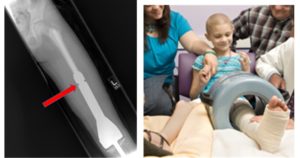Surgery. It’s one of the main ways we attack some cancers that are solid. We attempt to cut them out with ‘negative margins’. This means that the whole tumor comes out along with a swath of healthy tissue around it so that not one cancer cell is left behind. This seems like a straightforward concept but there are multiple ways this gets tricky; here are a few:
- The tumor is in an important location and it can’t be operated on because it’s too dangerous. This happens in brainstem tumors.
- The tumor is in a hard to reach place that makes it technically difficult to get at, such as deep in the face.
- The tumor is in a tight space and there is no room to take that extra swath of healthy tissue without major complications.
- The tumor is “infiltrative” which means there is no defined edge and it ‘bleeds’ or ‘seeps’ into the surrounding healthy tissues.
- The tumor is in the bone of a growing child.
I take care of patients with bone tumors, so I deal with #5 the most and can speak the most intelligently about it. The growth plate of bones is where we grow from. These are located on the ends of long bones. Unfortunately, a lot of bone tumors like to happen at the ends of long bones near those growth plates. If you cut out the bad bone and take the growth plate with it, then the bone will no longer grow. If a teenager has reached skeletal maturity (growth plates are closed) then the bone can be cut out and replaced with a rod. This rod is called an endoprosthesis (endo = internal, prosthesis = artificial body part) This is an example of what it would look like.


In these pictures above, you can see that the entire end of the thigh bone above the knee is gone. If this was a child that was 10 or 11 years old, then this leg would no longer grow properly. To get around this issue, we now have some very cool endoprostheses that can “grow” for the child.

Ninety percent of the time we can offer an option to ‘save’ the limb; this is called limb salvage surgery. The other ten percent of the time we may be forced to do some sort of amputation. While limb salvage techniques have come a long way in the past 30 years, the leg is never as good as it was before the operation. There are restrictions on activity and the muscles and their attachments can be affected, which can create limps and/or weakness. In certain situations, amputations can provide a better functional outcome than a limb salvage surgery. These two options (rod that doesn’t grow and rod that grows) are not the only two limb salvage options. Here I discuss a few more options.
#ChildhoodCancer365 #morethanfour

Wow Wendy you do a wonderful job of explaining this.